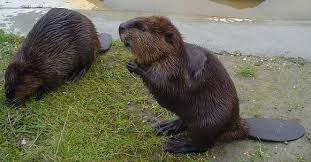The beaver (Castor fiber) is the largest rodent in Europe. It measures 75 to 90 centimeters and weighs 12 to 38 kilograms. The broad, scaly, horizontally flattened tail is 28 to 38 centimeters long.
 The coat is between yellowish brown and black in color and is composed of shiny water repellent guard hairs, beneath them dense, gray, scalloped and insulating wool like hair.
The coat is between yellowish brown and black in color and is composed of shiny water repellent guard hairs, beneath them dense, gray, scalloped and insulating wool like hair.
The legs are relatively short. The front paw has five fingers with long nails. He can firmly grasp branches and trunks and drag them. The hind legs are larger and wider and have membranes between the toes: webbed feet.
The head is blunt with small eyes, ears and nose of a beaver are aligned. When swimming they stabb just above the water. Nose and ears are closed. The cheek has a piece of tissue that closes the mouth when the animal gnaws underwater.
The beaver was hunted for its fur (beaver fur) and castor or beaver horny, a by his anal glands secreted musk-scented substance mixed with urine. In the 17th century it was used in medicine and perfumery. In castor is salicylic acid, one of the building blocks of aspirin. Beaver gets it in through eating willow bark.
He uses it to define his territory and to make his coat waterproof. Beavers have on the second toe of the hind legs special nails in order to polish the coat.
Water that is contaminated with cleaning agents can affect the water resistance of the coat.
Beavers are monogamous, some remains of their lifes together. They live in small family groups near water. Beaver mates in February. After a gestation period of 103 to 108 days one to six (average 2.7) pups are born in June. Young remain about two years in a family group.
They are usually seven or eight years old, but they can be twenty-five years if they do not starve, drown or die in traffic.
The beaver is a water- and day animal living in and around lakes, streams, ponds and marshes with adjacent forest areas. He is often active at night, especially at risk of disruption.The water should be at least 1 m deep, so it does not dry out in the summer and not completely freeze in the winter.
Fallen trees, exfoliated bark, shallow channels, dams, and lodges in the water betray his presence. They build a nest in an underground cave, or a lodge in the water. Which can be up to 200 meters long and 3 meters wide. The entrace(s) is under water, inaccessible to predators. The "living room", a hollow mountain of branches made windproof with mud and wood chips fed is above water. The middle part of the ceiling is not smeared, and serves as a vent hole. On cold days, there may be even a wisp of smoke hung over the castle. Before the living area is a "utility" where the beavers are cleaning and shaking them dry.
They arrange active the water by their dams and locks so that the entrance remains below and the living above water. Or so that air to breathe is under the ice. They even dig, up to 100 m long channels to transport beyond trunks and branches to their lodge or dam. Their water management creates rich habitats, for amphibians and others.
With their long sharp teeth they gnaw a 8 cm thick trunk in 5 minutes.
A 25 -centimeters thick tree they fell in less than four hours.
They can stay underwater for up to fifteen minutes, but a dive usually lasts five to six minutes.
When danger a beaver strikes with the tail on the water surface.
The beaver has a very extensive vegetarian menu. In summer he eats herbs, flowers, young shoots of plants, grasses and roots. He also eats all parts of trees. He has a preference for soft wood: ash, willow and poplar.
Beavers have a long appendix for digesting cellulose.
He does not hibernate. In the fall, he puts quite a food supply. With mud he anchors trunks, branches and twigs under water, near the entrance. The cold water keeps the nutritional value of the bark for long.
In 1754 the Church decided, because of its scaly tail and his life in the water, the beaver as fish, so it could also be eaten on Fridays and during Lent periods. This has certainly helped us eliminate the animal. In the Netherlands the last beaver was beaten to death in 1826 on the river IJssel.
Around 1990, he was reintroduced in the Benelux. In 2014 were near Maaseik 13 beavers killed by traffic, including one of 22kg!
The beaver is often confused with the coypu. However, that is smaller, has a round tail, prominent snout and usually swims with a portion of the back panel above the water.
Save a tree - eat a beaver!
